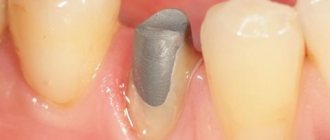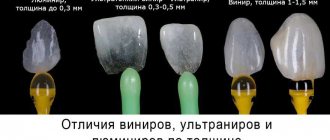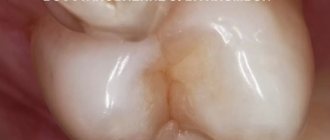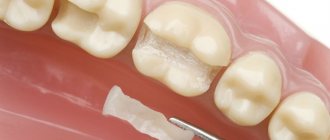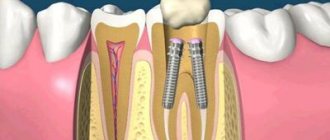Sometimes patients ask dentists: which is better, a pin or an inlay, and what is better to restore a damaged tooth? Despite the fact that these structures are somewhat similar and are intended for the same purpose - restoring severely damaged teeth while preserving their own roots - they still have a number of differences. To make it easier for the patient to decide, we will analyze the pros and cons of pins and inlays.
Content
- Details about the pin
- Details about the tab
- Materials for production
- What the inlay and pin have in common
- Differences
- What to choose - pin or tab
Currently, dentists offer many options for prosthetics and dental treatment. Modern technologies can solve almost any problem. It is important to choose the best option for a particular case. If treatment of a decayed tooth is required, the choice is between an inlay and a pin.
PROMOTION
Dental restoration, installation of fillings
from 2200 rub.
Watch the video: Dental crown on a core tab
Notice
: Undefined variable: post_id in
/home/c/ch75405/public_html/wp-content/themes/UltraSmile/single-item.php
on line
45 Notice
: Undefined variable: full in
/home/c/ch75405/public_html/wp-content /themes/UltraSmile/single-item.php
on line
46
Rate this article:
crown
Pin
This is a rod installed in the root of the tooth to strengthen it and ensure subsequent treatment. It is installed when there is severe destruction, when no more than half of the root remains. The materials used for manufacturing are polymers or metals. A serious disadvantage of metal pins is the need to greatly expand the root canal, as a result of which its strength decreases. Fiberglass pins do not have this drawback and are similar in characteristics to natural dentin.
When choosing a manufacturing material, we proceed from specific requirements:
- For prosthetics of the front teeth, fiberglass is used;
- Metal products are intended for chewing units with severe destruction;
- Carbon fiber is a universal option, suitable for any teeth.
There are two types of fastening:
- Passive – on dental cement, without load on the root;
- Active - the pin is screwed into the root using a thread.
Comparing methods: which is better - a stump tab or a pin
So, the question arises, which is better - a stump or a pin? We conducted a brief analysis by comparing the advantages and disadvantages of both prosthetic methods. All characteristics, pros and cons are placed in the table for convenience.
| Pin | Stump tab | |
| Number of doctor visits | 1 visit | 2 visits – during the first, impressions are taken and the tooth is prepared |
| Manufacturing | Pins are template structures | Inlays are created individually in the laboratory |
| Materials | Alloys of inexpensive metals | Ceramics, metal alloys, precious metals, zirconium dioxide |
| Possibility of developing allergies | High | Low, since hypoallergenic materials can be selected |
| Possibilities of prosthetics | The crown is built up on a post using composite materials | Various materials are used: composite building, or crowns (metal-ceramics, ceramics, zirconium dioxide) |
| Aesthetics of prosthetics | Medium – the metal base will be visible, the extended tooth will be noticeably darker | Very high due to the exact repetition of tooth anatomy and the choice of snow-white aesthetic materials |
| Main advantages | Affordable price, possibility of crown repair directly in the patient’s mouth | Root protection from destruction, high aesthetics, long service life |
| Main disadvantages | Rapid destruction of the root under load, relative aesthetics, short service life | High price |
| Life time | No more than 3-5 years | From 3-5 years and above |
| Price | From 4-5 thousand rubles including extensions | From 10 thousand rubles + crown |
To summarize, then, of course, it is worth giving preference to stump inlays. Such dentures ensure the reliability and functionality of the restored tooth. They can last for decades and the tooth will look like a natural one. But inlays are noticeably more expensive, so you need to make a choice primarily based on the condition of the tooth and your budget.
Tab
This is also a prosthetic design that imitates part of a tooth. Used for teeth located behind the canine teeth.
There are:
- Restorative inlays - to recreate the correct shape, bite and natural shade of the tooth;
- Stump inlays are placed under the crown and serve as the foundation for it.
The difference from the pin is in the device - the inlays consist of two parts - the pin itself and an element that replicates the tooth. The manufacturing process takes place under pressure at high temperatures. The root part is an attachment for the root and looks like a rod. The upper element follows the shape of a crown.
Design Features
A stump inlay is a structure made from a patient’s dental impression for attaching a crown. This type of denture is a combination of cast material of different alloys. The prosthesis is installed into the dental canal from the inside to strengthen the damaged dental crown.
A stump tab is the only way to restore a maximally damaged tooth (more than 70%).
The upper part of such a prosthesis looks like the stump of a ground tooth, which is where the name “stump” comes from. For special strength, the prosthesis is made by casting from various metal alloys.
This prosthetic model is not a crown. This is a completely different structure. It is difficult to do without this extremely reliable type of prosthetics in modern dentistry.
Stump tab, pin and crown: which is better
It is impossible to compare core inlays and crowns. These are prostheses of fundamentally different purposes, properties and configurations. And only the dentist can decide which type of prosthetics is preferable for a particular patient.
However, a core inlay is not used for teeth with very thin walls. In this case, a crown can more effectively cope with the task of strengthening the crown of the tooth. The crown will be especially strong if it is attached to the stump tab. At the same time, it is possible to maximally strengthen even the most worn teeth and completely restore their natural chewing function.
Both the post and core support strengthen damaged teeth. However, this type of prosthesis guarantees super-strength dental fasteners, uniform chewing load and protection from further destruction.
A very important advantage of the inlay is its fastening using a cement composition. This guarantees a tight fit to the tooth of any degree of wear and prevents the formation of cracks.
Material of manufacture
A variety of materials can be used, including:
- Metals and composites are the most popular option, they are easy to manufacture, durable and have an affordable price;
- Ceramic - similar to natural tooth enamel, the most aesthetic option;
- Zirconium - combines the best qualities of the previous options - they are aesthetically pleasing and durable, but are not very popular because they are very expensive.
A progressive method that wins
Until recently, the stump pin inlay for a tooth was not used in dentistry.
All reconstructions were fastened with conventional pins. They were extremely popular, they were widely advertised (mainly, of course, by manufacturing companies). The main advantages declared by sellers: the ability to facilitate and speed up the restoration process. Yes, indeed, the doctor used a standard composite reinforced with one or two anchor pins and performed the restoration in 1 session. It seemed that such a design would last forever; it surpassed its warranty period with dignity. But only 2-3 years passed and it collapsed, as the thin walls of the tooth quickly deformed from excessive load. The dentist could fix everything if it was a single crown, but if it was part of a multi-link bridge, the task became more complicated. One way or another, dentistry is actively developing and not so long ago a new device appeared - a stump pin insert. Initially, the tooth inlay did not gain much popularity, as it had a number of disadvantages (its production took longer, and the installation process was complex). Doctors, in order not to waste their time, tried not to advertise this opportunity to patients. But time has passed and now these stump pin inlays are the most in demand and popular. Most progressive dental clinics use them.
Differences
- The pin puts pressure on the root of the tooth, which can cause it to become loose; there is pressure on adjacent teeth, and the inlay eliminates this load.
- Time of use - the pin can be used for up to 3 years, the inlay - much longer, almost 10 years.
- The pin is a single design, but the tab can separate.
- It is not difficult to make a pin, but to make an inlay, laboratory specialists are involved and special studies are carried out.
- The installation of the pin is carried out in one visit to the dentist; to install the inlay, you will have to visit the doctor at least twice.
- If the tooth has a crooked root, you can only use an inlay.
- The cost of an inlay is significantly higher than a pin.
- Preparing the tooth for the installation of a pin is relatively gentle; in order to install the inlay, a large amount of tissue is removed.
How it is made
What stages must be completed in order for a patient to have a high-quality stump prosthesis installed?
The specificity of the installation of stump inlays is the individuality of their production for each clinical case.
Before installing these structures, thorough sanitation of the mouth, filling of the canals and removal of the destroyed pulp in them is required.
Main stages of the process
- The orthopedist prepares the dental cavity for installation of the inlay.
- Then the specialist selects the optimal type of material, taking into account the basic parameters of the desired material (shrinkage, hardness, bioinertness, residual elasticity, thermal conductivity).
- The orthodontist makes impressions of the patient’s jaws to ideally “fit” the prosthesis into the dentition (with the obligatory consideration of antagonist teeth). The blank model is sent to the dental office.
- The variability in the manufacture of the prosthesis must be taken into account: single-root or multi-root (depending on the anatomy of the tooth being restored).
- The dentist makes a prosthetic model from the material selected by the orthodontist. Then a wax model is made from the plaster sample. Only after this do they proceed to the manufacture of a finished stump prosthesis from the selected material (metal, ceramics, composite).
- The structure is covered with a special corrective shell and sent to the doctor.
- In the dental office, the doctor processes the dental cavity and the finished inlay. After this, the prosthetic model is installed on the patient.
- Hiding the stump model of the prosthesis under a crown or bridge.
Price
The stump model of the prosthesis is not a cheap dental structure. Its cost may vary from one dental office to another. The most inexpensive is the metal model (on average from 2,000 to 3,000 rubles). A prosthesis made of pressed ceramics costs about 12,000 rubles. And most of all you have to pay for the zirconium dioxide inlay (about 15,000 rubles).
If your tooth is damaged, but its root is not damaged, do not worry! Modern designs in the form of a stump tab will help you preserve and strengthen a hopeless tooth.
Sources used:
- I. Yu. Lebedenko, Orthopedic dentistry, 2012
- Seifollahi M. Preparation of lateral teeth for all-ceramic inlays
- https://medicine.wustl.edu/

